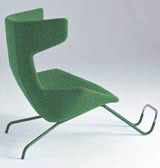Latin Passions
Combining latin passion with inspiration from the swiss alps, Alfredo Häberli’s work aims to put no-nonsense style above trendsetting fads.

Häberli sees himself as both Argentinean and Swiss. ‘I do feel that I have a bit of both nationalities in me – the Latin side is evident more in my character and the Swiss side in how I approach design,’ he explains. ‘I’m very impressed by the innovations present in Swiss products. I always try to make a small step forward in areas like typology or material – something beyond that which we already know.’ His recent product portfolio certainly shows the introduction of such ‘small steps’ of innovation through form, technique, or material without ever losing sight of commercial application. He scowls at ‘fashionable’ design, clearly struggling to resist the temptation of pointing out examples in the room.
Häberli’s client list is varied and multinational, including: Alias, Asplund, BD Ediciones de Diseño, Cappellini, ClassiCon, Driade, Iittala Luceplan, Magis, Offecct and Volvo. But Moroso is a favourite. ‘Here is a family company with a huge global brand image but a small infrastructure in terms of its operations. There are no corporate politics, so decisions happen quickly,’ he says. Pointing to the Skate chair, he says: ‘I sent Patrizia Moroso a 1:10 model. Within two weeks, the production manager had made a full-scale prototype, without any computer drawings.’ On similar grounds, he mentions Alias as another company with which collaborating is always a pleasure, this year on the TT range of padded seating.
All Häberli’s work, from lamps to shoes, glassware to chairs, jewellery to children’s toys, is defined by a lightness of materials, a confidence of form, and an organic, hi-tech graphic clarity. But there is also a strong human dimension as well. ‘I always need a person for whom I can create something,’ says Häberli. ‘Sometimes it’s the client, sometimes friends, or a person I imagine. But often it’s my own needs and observations, my instinct for a situation.’ And he clearly still gets a buzz from seeing his chairs masterly upholstered and stitched by hand at Moroso, while – at the other extreme – 50 000 of his Essence glassware pieces are sent through Iittala’s production line per day.
Häberli’s enthusiasm is refreshing. He makes you feel welcome in his world; he doesn’t take himself too seriously and still possesses that familiar creative insecurity beneath his outwardly confident persona. People are clearly drawn to him and by the end of our interview we are surrounded by Patricia Urquiola, Moroso, and a string of fellow designers, all jabbering away in a mix of English and Italian. I slip away to find respite again on Häberli’s new creation.
-
Post a comment




